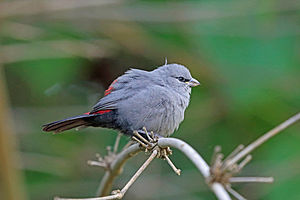Blacktail Schönbürzel
| Blacktail Schönbürzel | ||||||||||||
|---|---|---|---|---|---|---|---|---|---|---|---|---|

Blacktail Schönbürzel ( Estrilda perreini ) |
||||||||||||
| Systematics | ||||||||||||
|
||||||||||||
| Scientific name | ||||||||||||
| Estrilda perreini | ||||||||||||
| ( Vieillot , 1817) |
The Blacktail Schönbürzel ( Estrilda perreini ), also called Perein's Astrild , is an African species from the finch family . Two subspecies are distinguished for the species.
The IUCN classifies the black-tailed Schönbürzel as not endangered ( least concern ).
description
Black-tailed Schönbürzel reach a body length of eleven centimeters. There is no sexual dimorphism .
The black-tailed Schönbürzel is similar to the Schönbürzel , but does not have a red tail like this one, but a black one. It differs from the Cinderella Schönbürzel by a small, black chin patch. The lower beak is grayish and not reddish in the black-tailed Schönbürzel. The rump and the upper tail-coverts of the black-tailed rump are vivid red. Individual females also have some small red spots on the sides of their bodies. The under tail coverts are gray or black depending on the subspecies.
distribution and habitat
The distribution area of the black-tailed Schönbürzel extends from the south of Gabon through the north of Angola and the south of the Democratic Republic of the Congo to the northwestern shore of Lake Tanganyika . In a southerly direction it extends over Mozambique , southern Malawi and western Zimbabwe to the coastal area in Kwazulu-Natal . The habitat of the black-tailed Schönbürzel are moist, grass-strewn bush forest thickets and evergreen primary forests. He spends a lot of time in gallery forests. It is less common in drier forests, but is completely absent in dry forests proper. It is not very common in most regions of its range. In most regions the black-tailed Schönbürzel is a resident bird. The subspecies E. p. Occurring in southern Zimbabwe to southern Zululand and Natal . However, incana winters north of its breeding area in southern Mozambique.
Way of life
The black-tailed Schönbürzel can be observed predominantly individually or in pairs. It is therefore often overlooked. It only eats small grass seeds, it finds its food mainly on the ground. While foraging, it stays near thickets.
The breeding season in South Africa falls in the southern summer and lasts from October to March. Here he raises two broods a year. In other regions it breeds towards the end of the rainy season. The nests stand individually and are usually between 2.5 and five meters above the ground. Like some other species of fine finch, it shows a halo in which the male presents long blades of grass in its beak to the female.
The nest is a ball nest that is built by both parent birds. Occasionally he also uses old abandoned nests of other finches and weaver birds. The clutch consists of three to six white eggs. They are incubated by both parent birds. The breeding season averages twelve days for captive birds. The nestlings are cared for by both parent birds. The nestling period in captive birds is 19 to 21 days. The young birds return to the nest for a period of about seven days at night after they have fled.
attitude
The black-tailed Schönbürzel plays only a subordinate role in the keeping of ornamental birds. Individual birds of this species appear to have entered the market in the 1930s. After that, they were missing for years, until in 1966 ten pairs were traded in Switzerland. In recent years, however, these birds have occasionally been sold and are now regularly bred by a small group of keepers. They are considered to be very peaceful and suitable for community attitudes. However, they are very warmth-loving and must be kept at temperatures of at least 24 degrees.
In Mozambique, the population is declining in one region because, in addition to habitat destruction, a larger part of the population is caught annually for the export of cage birds.
supporting documents
literature
- Peter Clement, Alan Harris, John Davis: Finches and Sparrows - An Identification Guide , Christopher Helm, London 1993, ISBN 0-7136-8017-2
- C. Hilary Fry and Stuart Keith (Eds.): The Birds of Africa. Volume VII. Christopher Helm, London 2004, ISBN 0-7136-6531-9 .
- Jürgen Nicolai (Ed.), Joachim Steinbacher (Ed.), Renate van den Elzen, Gerhard Hofmann, Claudia Mettke-Hofmann: Prachtfinken - Afrika , Series Handbuch der Vogelpflege, Eugen Ulmer Verlag, Stuttgart 2007, ISBN 978-3-8001- 4964-3
Single receipts
- ↑ Nicolai et al., P. 215
- ↑ Clement et al., P. 367
- ↑ Fry et al., P. 290
- ↑ Fry et al., P. 290
- ↑ Nicolai et al., P. 217
- ↑ Fry et al., P. 289
Web link
- Estrilda perreini inthe IUCN 2013 Red List of Threatened Species . Listed by: BirdLife International, 2012. Retrieved October 5, 2013.